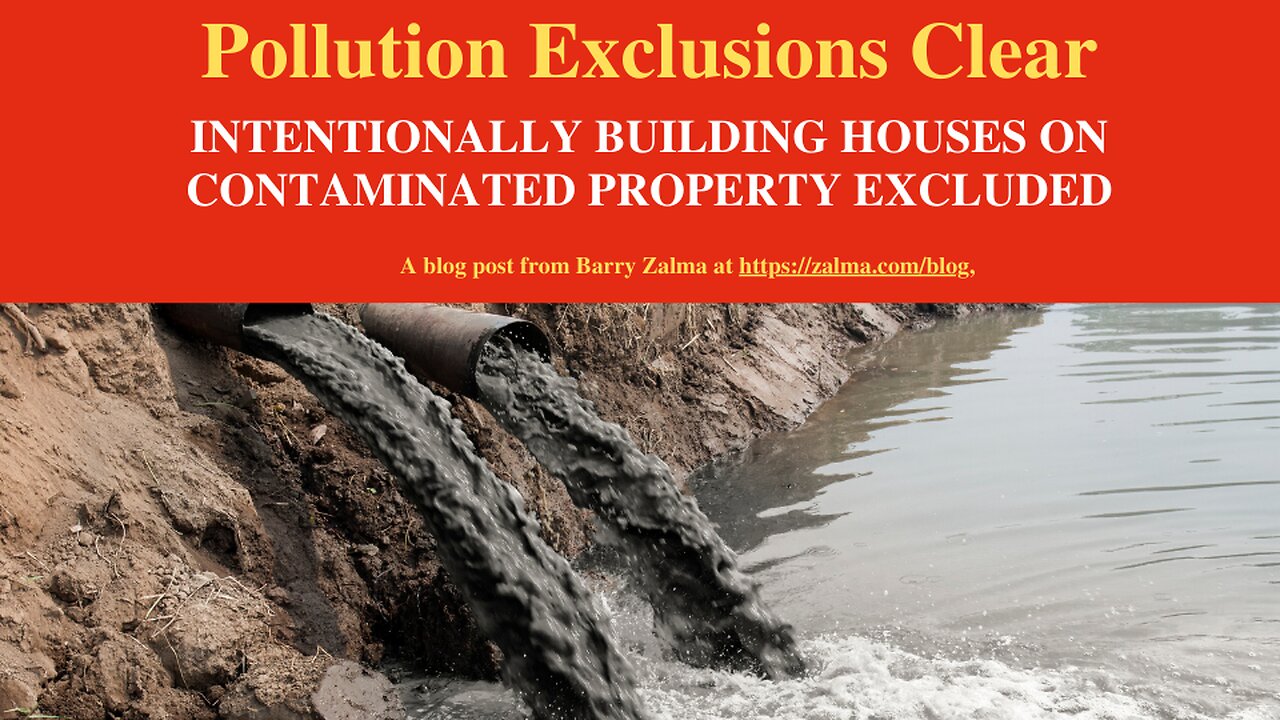Premium Only Content

Pollution Exclusions Clear
Intentionally Building Houses on Contaminated Property Excluded
POLLUTERS FORCED INTO BANKRUPTCY
Plaintiffs Victor Rosario, Nilda Maldonado, Jose Flores, and Noemi Flores appealed from three Law Division orders dismissing their second amended complaint against the defendant insurance carriers on dispositive cross-motions on whether insurance coverage applies. Having obtained a nearly $2 million judgment against the bankrupt developer of their residential properties – for failing to disclose their homes were built on contaminated properties – plaintiffs sought the proceeds of the comprehensive general liability (CGL) policies issued by the defendant insurance carriers to the developer. The motion judge in the present action concluded the pollution exclusion contained in defendants' CGL policies precluded coverage.
Victor Rosario, Nilda Maldonado, Jose Flores, and Noemi Flores v. The Hartford Fire Insurance Co., and The Western World Insurance Co., No. A-1968-20, Superior Court of New Jersey, Appellate Division (January 4, 2023)
The Plaintiffs purchased a single-family homes from developer Marco Construction and Management, Inc. in 2006.
Unbeknownst to plaintiffs, before Marco Construction subdivided the lots, they were utilized by the previous owner and co-developer, Stephan Musey, Jr., for commercial purposes that contaminated the property. Automotive fluids and waste oil were discharged into floor drains and the soil. In 1988, the underground storage tanks were removed from the site without proper notice to the authorities. Thereafter, the Department of Environmental Protection (DEP) directed Musey to conduct a remedial investigation of the property, but it was not completed.
On December 31, 2004, Musey and Dominic Antonini, the principal of Marco Construction, executed a joint venture agreement to develop the property. Antonini was apprised of the property's prior usage. Before Marco Construction took title to the property in February 2005, Antonini received several documents confirming the presence of outstanding environmental issues on the site; thereafter Antonini was told the property was contaminated. Later that year, Antonini built two single-family homes on the subdivided lot. However, Antonini failed to disclose the environmental issues to the realtors or prospective purchasers, including plaintiffs.
THE AVAILABLE INSURANCE
The following CGL policies issued by the defendant insurance carriers to Marco Construction are at issue in this appeal:
defendant Hartford Fire Insurance Company's policy, in effect from April 20, 2004 to May 20, 2005 (Hartford policy); and
defendant Western World Insurance Company's policy issued for the following year, May 20, 2005 to May 20, 2006 (Western World policy).
Both policies provided substantially similar coverage. Each policy contained virtually identical pollution exclusions and exceptions to those exclusions. In pertinent part, the policies provided:
(1) "Bodily injury "or "property damage" arising out of the actual, alleged or threatened discharge, dispersal, seepage, migration, release or escape of "pollutants":
(a) At or from any premises, site or location which is or was at any time owned or occupied by, or rented or loaned to any insured. However, this subparagraph does not apply to: ....
(ii) "Bodily injury" or "property damage" for which you may be held liable, if you are a contractor and the owner or lessee of such premises, site or location has been added to your policy as an additional insured with respect to your ongoing operations performed for that additional insured at that premises, site or location and such premises, site or location is not and never was owned or occupied by, or rented or loaned to, any insured, other than that additional insured [(pollution exclusion exception)] ....
The policies also contained exclusions for expected or intended injury, precluding coverage, in pertinent part, for: "'Bodily injury' or 'property damage' expected or intended from the standpoint of the insured." In addition, Western World's policy excluded coverage for known injuries or damages, defined as "bodily injury or property damage which first occurs before the inception date of the policy but continues to occur during the policy period if such bodily injury or property damage is known to any insured prior to the inception date of this policy."
FACTUAL BACKGROUND
Plaintiffs filed the underlying action. In May 2008, Marco Construction, through its insurance agent, filed a notice of claim under the Hartford policy, advising: "Claimants allege that insured subdivided a property that had known chemical pollutants. Following an investigation, on August 11, 2008, Hartford denied coverage under the pollution and expected or intended injury exclusions set forth in its policy.
Marco Construction demanded Hartford and Western World provide "defense and liability coverage protection." Both insurers refused.
In June 2014, a five-day bench trial was conducted in the underlying matter against the sellers and builders. On October 16, 2014, the trial court issued a thirty-five-page written opinion accompanying its aggregate judgment of $1,930,118.86, plus interest, on most of plaintiffs' claims. Among several other factual findings, the court determined, "Antonini knew that the contamination issues had not yet been resolved at the site when he agreed to allow Marco Construction to take title to the property." The court further found Marco Construction and Antonini were aware "the property was contaminated before Antonini began excavating the foundations" and "before he built any of the houses" because Trischitta, "told Antonini that 'this ground is contaminated.'"
Following plaintiffs' unsuccessful efforts to collect the judgment, a writ of execution was issued against the assets of Marco Construction and Antonini in September 2018. However, the writ was returned unsatisfied.
Thereafter plaintiffs sued Antonini, Marco Construction, and Hartford, seeking to satisfy the October 16, 2014 judgment. In October 2020, Western World moved to dismiss the complaint for failure to state a claim. Immediately following oral argument on January 8, 2021, the motion judge issued a decision dismissing plaintiffs' claims on summary judgment. The motion judge also determined the known injury and punitive damages exclusions barred coverage under the policies.
THE APPEAL
The interpretation of an insurance contract is a question of law for the court to determine and can be resolved on summary judgment. Courts should interpret insurance policies according to their plain, ordinary meaning. If there are no ambiguities in the language, courts cannot write for the insured a better policy of insurance than the one purchased.
The pollution exclusion unambiguously excluded coverage for: "'Bodily injury' or 'property damage' arising out of the actual, alleged or threatened discharge, dispersal, seepage, migration, release or escape of 'pollutants'" at the property, which was owned by Marco Construction during the policy periods. The record evidence established Marco Construction and Antonini knew of the property's contaminated status as early as 2004, when Antonini learned of the property's prior usage. The court, therefore concluded that the insurers satisfied their burden of demonstrating the pollution exclusion contained in their policies applied.
The plaintiffs' last attempt related to a Certificate of Insurance issued to a bank. The court did away with that argument noting that Certificates of Insurance do not create or bind coverage. A standard Certificate of Insurance only evidences the existence of the policies to which it refers; it does not alter the terms of an indemnity agreement or the parties' contract, nor does it alter or amend the terms of the policies to which it refers. It is not an insurance policy.
Accordingly, the court concluded that a certificate conferred no rights on its holder, Sterling Bank. The trial court's decision was affirmed.
ZALMA OPINION
No insurance contract insures against any possible risk of loss. For the last few decades CGL policies exclude pollution caused damages and all policies - for the last three centuries - exclude intentional acts. In this case the developers, with knowledge that the property was contaminated, knew they were required to eliminate the contamination by order of the appropriate federal agencies, did nothing to cure the contamination, and built houses on the contaminated property and sold it to innocent buyers. That type of tortious, and probably criminal act, is never an act that can be insured against.
(c) 2023 Barry Zalma & ClaimSchool, Inc.
Subscribe and receive videos limited to subscribers of Excellence in Claims Handling at locals.com https://zalmaoninsurance.locals.com/subscribe.
Go to substack at substack.com/refer/barryzalma Consider subscribing to my publications at substack at substack.com/refer/barryzalma
Barry Zalma, Esq., CFE, now limits his practice to service as an insurance consultant specializing in insurance coverage, insurance claims handling, insurance bad faith and insurance fraud almost equally for insurers and policyholders. He practiced law in California for more than 44 years as an insurance coverage and claims handling lawyer and more than 54 years in the insurance business. He is available at http://www.zalma.com and zalma@zalma.com
Write to Mr. Zalma at zalma@zalma.com; http://www.zalma.com; http://zalma.com/blog; daily articles are published at https://zalma.substack.com. Go to the podcast Zalma On Insurance at https://anchor.fm/barry-zalma; Follow Mr. Zalma on Twitter at https://twitter.com/bzalma; Go to Barry Zalma videos at Rumble.com at https://rumble.com/c/c-262921; Go to Barry Zalma on YouTube- https://www.youtube.com/channel/UCysiZklEtxZsSF9DfC0Expg; Go to the Insurance Claims Library – https://zalma.com/blog/insurance-claims-library
-
 7:40
7:40
Barry Zalma, Inc. on Insurance Law
1 year agoLoss of Inventory by Bankruptcy
184 -
 UPCOMING
UPCOMING
Price of Reason
7 hours agoTrump FIRES Fed Governor Lisa Cook! Cracker Barrel CRISIS Continues! James Gunn DCU Woes! Gamescon!
2471 -
 LIVE
LIVE
FreshandFit
1 hour agoTyreek Hill Pays Ex Wife $1 Million in Ongoing Fees From Divorce?!
4,354 watching -
 LIVE
LIVE
Inverted World Live
3 hours agoHaunted Dolls Hack Amazon Alexa | Ep. 98
10,819 watching -
 LIVE
LIVE
Laura Loomer
3 hours agoEP140: Loomer EXPOSES Islamification At US State Department
1,010 watching -
 3:05:00
3:05:00
TimcastIRL
3 hours agoTrump Floats Accepting 600,000 Chinese Student Visas, MAGA Uproar | Timcast IRL
166K93 -
 DVR
DVR
SpartakusLIVE
9 hours ago$20,000 Hide and Seek Tourney w/ Stonemountain64 || #1 Rat wins the BIG CHEESE
49.3K -
 2:34:02
2:34:02
Barry Cunningham
4 hours agoLISA COOK | ADAM SCHIFF | LETITIA JAMES | ARE THEY BEING SACRIFICED BY THE DEEP STATE?
68.4K34 -
 1:36:19
1:36:19
Flyover Conservatives
12 hours agoOnly 17% of Millennials Hit These 5 Adult Milestones—Why?; What If Childhood Trauma Is Behind Your Health Problems? - Dr. Troy Spurrill | FOC Show
18.6K2 -
 4:49:04
4:49:04
HogansAlleyHero
14 hours ago💥CHASING DOPAMINE💥✅TRUMP SAYS BATTLEFIELD IS THE BEST✅
24.7K